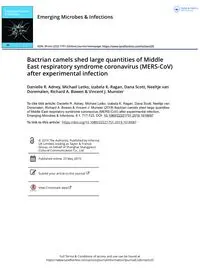
2019 Bactrian camels shed large quantities of Middle East respiratory syndrome coronavirus (MERS-CoV) after experimental PDF
Preview 2019 Bactrian camels shed large quantities of Middle East respiratory syndrome coronavirus (MERS-CoV) after experimental
Full Terms & Conditions of access and use can be found at https://www.tandfonline.com/action/journalInformation?journalCode=temi20 Emerging Microbes & Infections ISSN: (Print) 2222-1751 (Online) Journal homepage: https://www.tandfonline.com/loi/temi20 Bactrian camels shed large quantities of Middle East respiratory syndrome coronavirus (MERS-CoV) after experimental infection Danielle R. Adney, Michael Letko, Izabela K. Ragan, Dana Scott, Neeltje van Doremalen, Richard A. Bowen & Vincent J. Munster To cite this article: Danielle R. Adney, Michael Letko, Izabela K. Ragan, Dana Scott, Neeltje van Doremalen, Richard A. Bowen & Vincent J. Munster (2019) Bactrian camels shed large quantities of Middle East respiratory syndrome coronavirus (MERS-CoV) after experimental infection, Emerging Microbes & Infections, 8:1, 717-723, DOI: 10.1080/22221751.2019.1618687 To link to this article: https://doi.org/10.1080/22221751.2019.1618687 © 2019 The Author(s). Published by Informa UK Limited, trading as Taylor & Francis Group, on behalf of Shanghai Shangyixun Cultural Communication Co., Ltd. Published online: 23 May 2019. Submit your article to this journal View Crossmark data Bactrian camels shed large quantities of Middle East respiratory syndrome coronavirus (MERS-CoV) after experimental infection* Danielle R. Adneya, Michael Letkob, Izabela K. Ragana, Dana Scottb, Neeltje van Doremalenb, Richard A. Bowena and Vincent J. Munster b aDepartment of Biomedical Sciences, Colorado State University, Fort Collins, CO, USA; bRocky Mountain Laboratories, National Institute of Allergy and Infectious Diseases, National Institutes of Health, Hamilton, MT, USA ABSTRACT In 2012, Middle East respiratory syndrome coronavirus (MERS-CoV) emerged. To date, more than 2300 cases have been reported, with an approximate case fatality rate of 35%. Epidemiological investigations identified dromedary camels as the source of MERS-CoV zoonotic transmission and evidence of MERS-CoV circulation has been observed throughout the original range of distribution. Other new-world camelids, alpacas and llamas, are also susceptible to MERS-CoV infection. Currently, it is unknown whether Bactrian camels are susceptible to infection. The distribution of Bactrian camels overlaps partly with that of the dromedary camel in west and central Asia. The receptor for MERS-CoV, DPP4, of the Bactrian camel was 98.3% identical to the dromedary camel DPP4, and 100% identical for the 14 residues which interact with the MERS-CoV spike receptor. Upon intranasal inoculation with 107 plaque-forming units of MERS-CoV, animals developed a transient, primarily upper respiratory tract infection. Clinical signs of the MERS-CoV infection were benign, but shedding of large quantities of MERS-CoV from the URT was observed. These data are similar to infections reported with dromedary camel infections and indicate that Bactrians are susceptible to MERS-CoV and given their overlapping range are at risk of introduction and establishment of MERS-CoV within the Bactrian camel populations. ARTICLE HISTORY Received 5 April 2019; Revised 8 May 2019; Accepted 9 May 2019 KEYWORDS MERS-CoV; Bactrian camel; dromedary camel; virus shedding; natural reservoir Introduction Middle East respiratory syndrome coronavirus (MERS- CoV) circulates in dromedary camels and is respon- sible for severe respiratory disease in humans [1–9]. Experimental infections and field observations indicate that infected dromedaries shed large quantities of virus via nasal secretions and that signs of clinical disease are limited to rhinorrhea and a mild elevation in body temperature [10–12]. Infectious virus was detected in nasal swabs collected during the first week from exper- imentally infected dromedaries and RNA was detected for 35 days post-infection (dpi) [10,11,13,14]. In addition, productive infections after experimental inoculation with MERS-CoV of new world camelids, llama’s and alpaca, have been reported suggesting a broad host tropism of MERS-CoV for camelids [13,15,16]. Old world camelids include dromedary and Bactrian camels. Bactrian camels consist of two subspecies: the critically endangered wild Bactrian camels (Camelus bactrianus ferus), and domesticated Bactrian camels (Camelus bactrianus bactrianus). They are distributed over Western, Central and South Asia, including an area that overlaps with the distribution of dromedary camels (Figure 1A) [17,18]. A 2014 survey of 30 Bac- trian camels from 12 herds in southern Mongolia failed to detect circulation of MERS-CoV either by qRT-PCR on nasal swabs or serology, indicating either that the virus was not circulating in these herds or that these animals are not susceptible to infection [19]. Similarly, a 2015 survey of 190 Bactrian camels from 10 herds in the West Inner Mongolia Autonomous Region of China failed to detect circulation of MERS-CoV by qRT-PCR or serology [20]. Sero-surveillance con- ducted in Kazakhstan did not detected any evidence for circulation of MERS-CoV in 455 sampled dromed- ary camels and 95 Bactrian camels [21]. In order to determine the susceptibility of Bactrian camels to infec- tion with MERS-CoV and the potential risk for intro- duction of MERS-CoV in areas with Bactrian camels, we inoculated two Bactrian camels and monitored them for nasal shedding and seroconversion and com- pared the response to experimental historic data from dromedary camels. © 2019 The Author(s). Published by Informa UK Limited, trading as Taylor & Francis Group, on behalf of Shanghai Shangyixun Cultural Communication Co., Ltd. This is an Open Access article distributed under the terms of the Creative Commons Attribution License (http://creativecommons.org/licenses/by/4.0/), which permits unrestricted use, distribution, and reproduction in any medium, provided the original work is properly cited. CONTACT Vincent J. Munster
